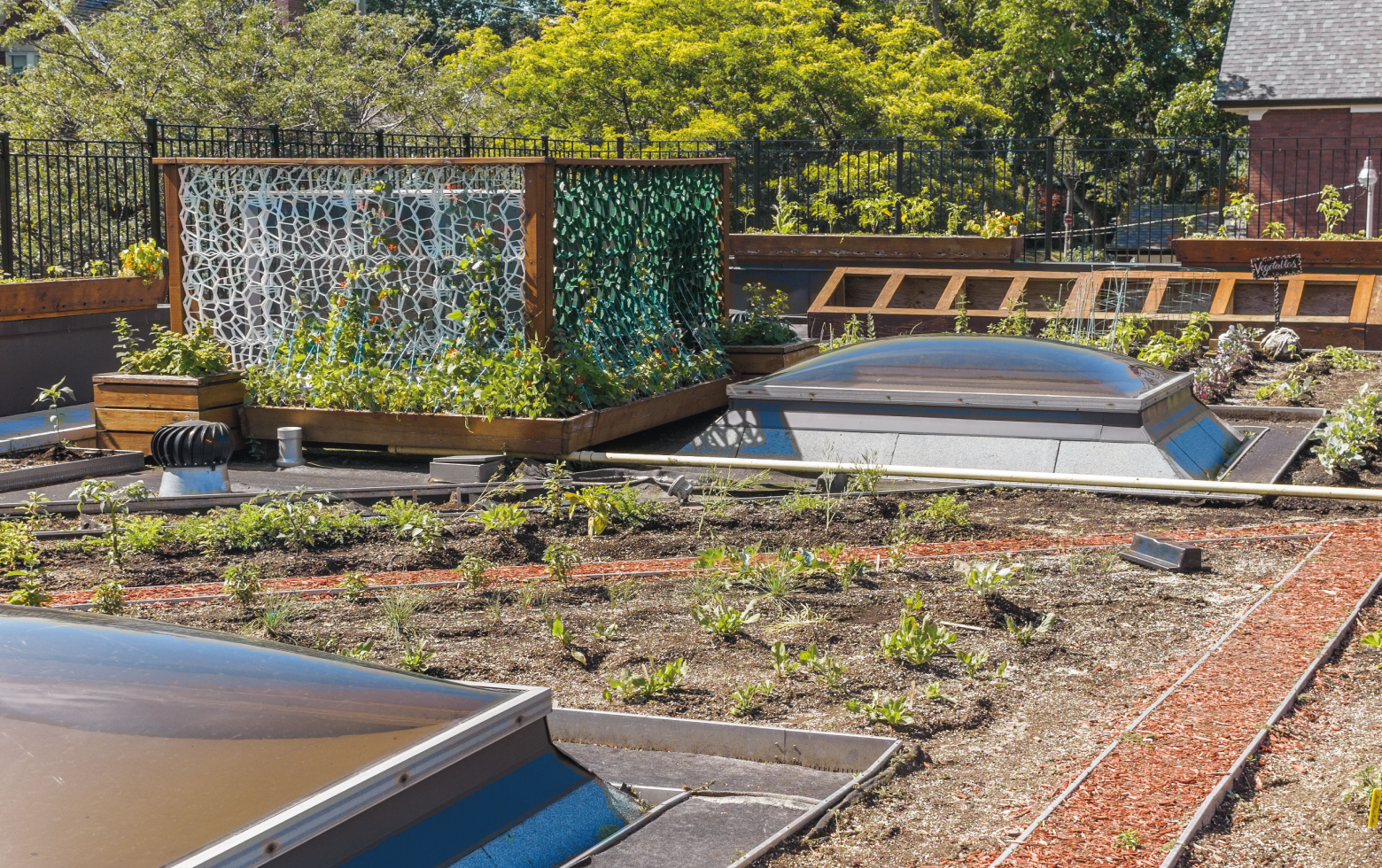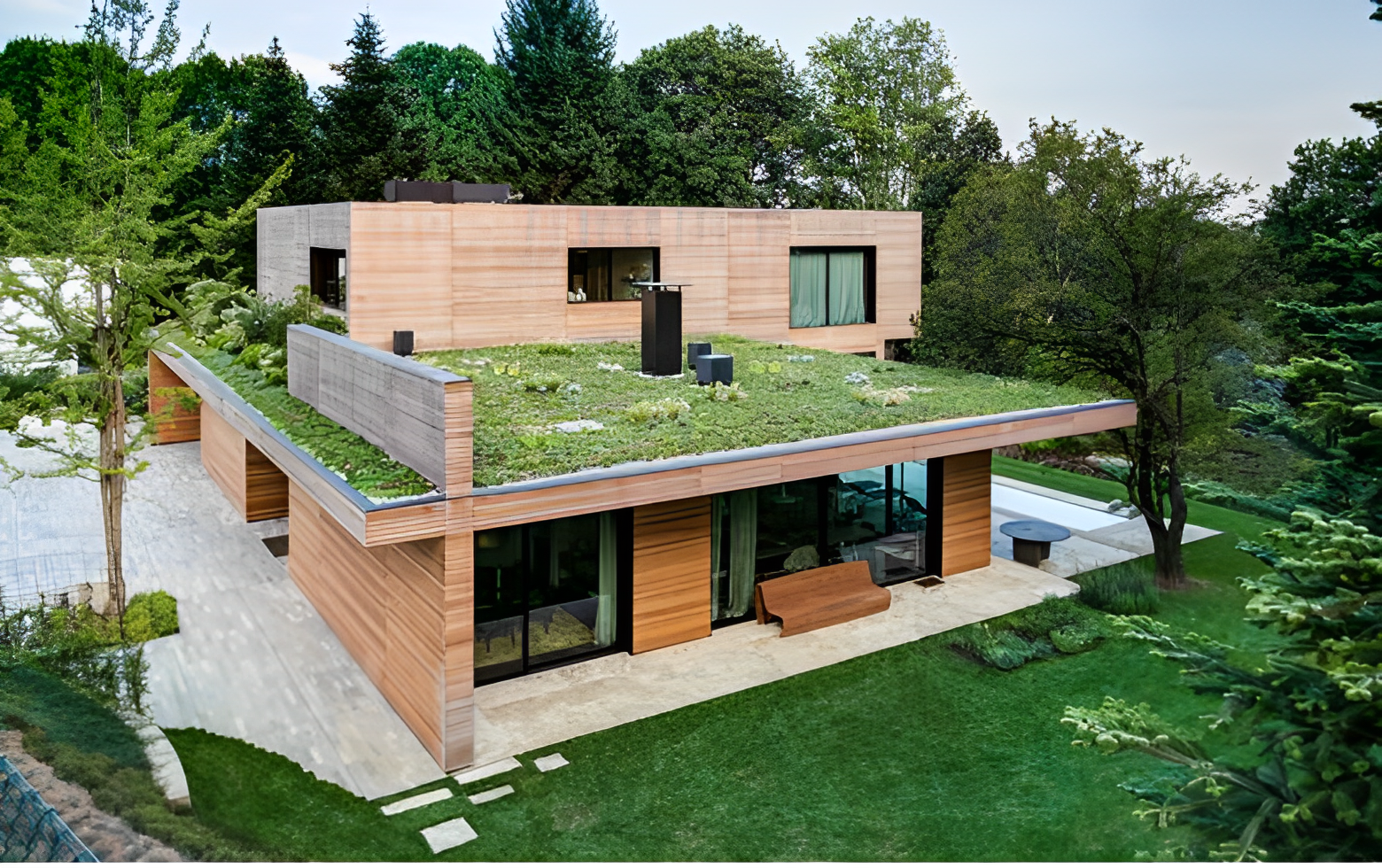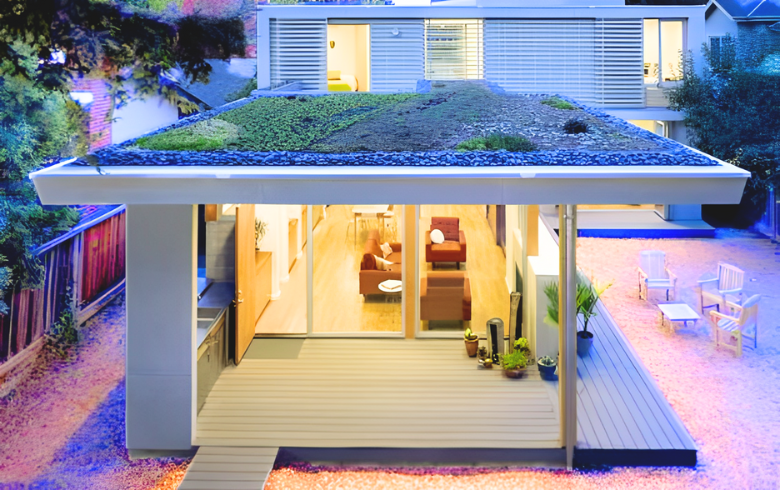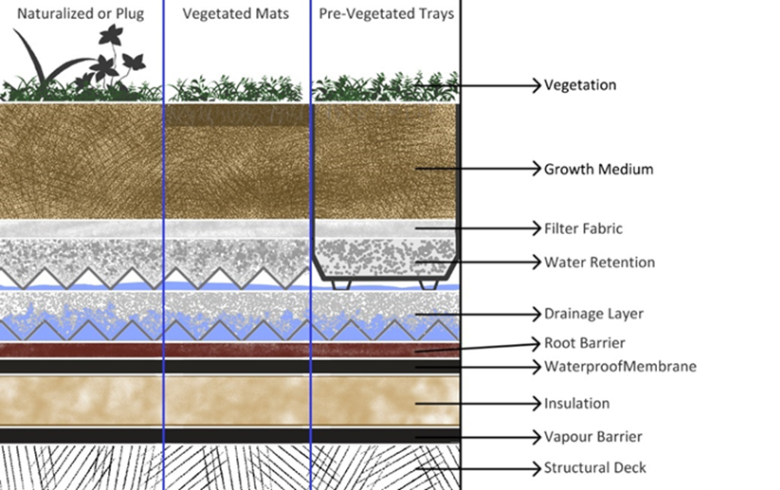
As we strive toward a more sustainable future, architecture and design have evolved to incorporate eco-friendly solutions. Urbanization has led to the destruction of natural habitats, and rooftops have become an overlooked space with the potential for positive environmental impact. Enter green roof systems, an eco-friendly option that not only reduces energy costs but also creates a habitat for flora and fauna, improves air quality, and protects buildings. In this article, we’ll explore the basics of green roofs, their construction, the benefits they offer, and whether you should consider installing one on your property.
What is a green roof?
Unlike traditional flat concrete and asphalt shingled roofs, green roofs are covered partially or entirely with vegetation. The plants on the roof can vary from grasses and herbs to shrubs and trees. While there are other options for beneficial roofs, green roof systems offer unique environmental and social advantages for both the building and the surrounding area. They can be installed on new and existing buildings, from small residential structures to large commercial properties.
They may be combined with other eco-friendly roofing options, such as blue roofs, which retain water, and white roofs, which reflect sunlight away from urban areas.
What are the types of living roofs?
Living roofs are classified by the plant species they can support and the depth of growth substrate they hold. Plants that are larger or produce fruits and vegetables require more substrate for their roots.
Intensive green roof
An intensive green roof typically features larger trees, shrubs, and lots of ground cover. It’s often designed for social use or gardening. The plants it can hold require a deeper growth substrate – at least 25 cm (10 inches). Due to the added weight per square foot of plants and substrate, a strong supporting structure is a must. However, this structure can be expensive to build and maintain.

Semi-intensive green roof
Falling somewhere between intensive and extensive, semi-intensive green roof systems usually have smaller shrubs and bushes, as well as ground cover, to produce visually pleasing spaces. The substrate layer is usually between 15 and 25 cm (6 and 10 inches) thick, allowing for a diverse range of plants to thrive while keeping weight limitations in mind.

Extensive green roof
An extensive green roof system is the simplest and least expensive option. It features short grasses or succulents and a thin layer of substrate for the plants to grow in. It’s much lighter per square foot than other options due to its shallow substrate depth of 15 cm (6 inches) or less. It is commonly used for residential roofs as it is lightweight and affordable while still offering many benefits. This is the only type of green roof that can be installed on roofs with steep slopes.

Brown roof
Lastly, there are brown roof systems. These are used to sustain local natural biodiversity, with a focus on allowing select local plants to thrive and natural seeding through wind and animal life deposition. The infrastructure required for plant growth is not emphasized.

What are green roofs made of?
Although green roof systems have varying structures, they’re typically built using the same materials and have the same general structure. Further, the specific materials used for each layer may differ based on the needs of the particular green roof system.

Structural deck
The structural deck in green roof systems is the base layer of the roof. It supports the entire green roof assembly and is typically made of concrete, steel, or wood. It is designed to withstand the weight of the green roof components as well as any additional loads, such as wind or snow.
Vapour barrier
Installed between the deck and the insulation, the vapour barrier prevents moisture from entering the structure and causing damage over time. A properly installed vapour barrier will help prevent mould growth, rot, and decreased energy efficiency.
Insulation
Insulation is a crucial component of any roof but is particularly important in green roofs. It protects the roots of plants from extreme temperatures and helps lower heating costs in buildings.
Waterproofing membrane
The waterproofing membrane layer is designed to prevent water from penetrating the roof and reaching the underlying structure. It’s usually made of a durable synthetic material like PVC or TPO and is installed between the insulation and root barrier. The waterproofing membrane is a crucial component: it protects the roof from water damage, prevents leaks, and stops rot and mould from forming.
Root barrier or protection mat
Vegetation, particularly larger plants, can damage buildings with its extensive root structures. While they grow slowly, roots can erode and break through various materials, including water barriers and concrete. To prevent this damage, root barriers are installed. They are made of non-toxic and flexible materials and redirect the roots sideways, away from the building structure.
Drainage layer
While water is necessary for the growth of vegetation on a green roof, excess water can damage or kill plants and add significant weight to the building’s structural supports. The drainage layer is designed to allow excess water to flow to a more suitable location. Typically, this layer is made using a combination of preformed plastic, rocks, and other materials that promote water flow.
Water storage layer
The water storage layer is an optional but beneficial component of a green roof system. It’s largely made up of the same materials as the drainage layer, namely river rocks and preformed plastic. The primary function of this layer is to store excess water until it is used by the plants, evaporates, or slowly drains to the drainage layer.
Filter fabric
While we want the plants to thrive, we don’t want fine particulates from the growing medium escaping into the drainage layer. Filter fabric separates the substrate from the water to prevent this.
Irrigation
Several irrigation techniques, such as sprayers, internal piping, and drips from above, can provide water to plants. Note that plants’ needs vary: some can easily withstand drought, while others are high maintenance. Sprayers and drip irrigation can be used to target specific areas and ensure all plants receive adequate water and nutrients.
Growth medium or substrate
All plants need something to grow in, but regular topsoil is far too heavy for use on buildings and less effective than artificial mediums at retaining water over time. Artificial growth mediums are a mix of natural materials such as peat, mulch, vermiculite, and perlite to create optimal growth environments while lowering weight.
Vegetation
Vegetation is a crucial component of any green roof system. Depending on the purpose and type of green roof, the preferred vegetation will vary.
For example, extensive green roofs typically include low-growing, drought-resistant plants such as mosses and grasses. They require minimal maintenance and can withstand harsh weather conditions, making them ideal for buildings with limited roof access or capacity for regular maintenance.
On the other hand, intensive green roofs are more like traditional rooftop gardens and can include a wider range of plants, such as trees, shrubs, and vegetables. They often need complex systems to sustain root depth and meet nutrient needs, as well as regular maintenance performed by a gardener.
Choosing plants for a green roof
Once you’ve decided on the living roof you want to install, it’s time to choose vegetation and a suitable installation method. Certain plants are more adaptable to potential low-water conditions, while others are chosen to promote biodiversity or simply visual appeal.
Which plants are best for a living roof?
To promote biodiversity in artificially created environments such as green roofs, use a variety of local plants that are beneficial to the local fauna. Drought-resistant plants like succulents are popular, with sedum being the most common option for green roofs. However, some plants, such as blue sedge grass and trailing ice plants, may require more attention and care.
If you’re building a green roof in Ontario or Quebec, we recommend using local plants to promote biodiversity. An extensive list of suitable plants is available in the design guidelines for biodiverse green roofs document, provided by the City of Toronto.

Installation methods
After you choose what plants you’d like for your living roof, you need to install them. Extensive roofs have many installation options, but intensive designs are limited to plugs and naturalization due to their depth.

Vegetated mats
Vegetated mats are produced in a similar way to sod mats. They’re grown on a substrate (e.g., coconut coir) with a mesh liner to hold all the roots and growth medium together. The mats are then cut into rolls and placed on the green roof, providing instant and even coverage. They’re most effective for extensive and shallower sections of semi-intensive green roofs.
Pre-vegetated trays
Pre-vegetated trays are best if you plan to install plants in a grid pattern on the green roof. They often include many of the lower layers and can be installed as a full planting solution. However, because the trays often do not allow water transfer between each other, they can cause uneven moisture distribution.
Plug installation
Most similar to traditional landscaping, the plug installation method involves growing plants in sectioned containers with ample nutrients until they develop strong roots. The plants are then unearthed as a single plug of dirt and planted in holes dug in the substrate. Although it requires more maintenance and time for the plants to get fully situated, this method produces a natural roof of any type.
Naturalized green roofs
Naturalized green roofs (e.g., brown roofs) involve allowing seeds to be deposited by wind and wildlife, resulting in a diverse mixture of local vegetation. This approach can also be combined with a plug installation to create a hybrid solution, but it needs a lot of care early on.
How much does a green roof cost?
Creating a green space can vary in cost greatly depending on the type of green roof system. For example, an extensive green roof typically costs $10 to $20 more per square foot than traditional roofing. Intensive green roofs, however, can cost over $150 per square foot if you need to build a support structure that can withstand the additional load (from the deep substrate layer).
Those looking to build a green roof system on an existing roof may want to call in a professional to evaluate its load limits. Additional modifications may rack up further costs, especially if you need to call in a structural engineer or an architect. Lastly, maintenance costs start at $1 per square foot in the first few years but lower to $0.10 over time.
How long does a green roof last?
Green roofs have been around for thousands of years, and some of them are still standing! While there isn’t enough data to determine how long green roof systems can last, we do know that poor maintenance can lower their lifespan considerably. Though, even if they get damaged by the elements, material failure, or inadequate upkeep, there is no evidence to suggest that they would need to be rebuilt completely like shingled and tiled roofs.
What are the benefits of a green roof for commercial and residential properties?
Green roof construction offers major benefits, such as improving the surrounding community and city infrastructure, enhancing building value and efficiency, and positively impacting the environment. Let’s take a closer look at each type.
Public benefits of a living roof
While the positive effects of green roofs on the environment and energy efficiency are undeniable, measuring their social impacts can be challenging. Nevertheless, research indicates that green spaces, including green roofs, can benefit health and social cohesion.
- Positive social impact. Research done on a green roof at a campus in Sydney, Australia, shows that living roofs promote social cohesion by fostering a stronger sense of community and attachment to the location.
- Improved mental health and well-being. Urban environments can negatively impact residents’ mental health, while access to green spaces can have positive effects. Research conducted in Seoul, South Korea, on the effects of green roofs on mental health shows that green roofs can improve quality of life and citizens’ overall satisfaction.
- Increased urban agriculture. In cities, agriculture is often neglected in favour of further urbanization. To combat this, intensive green roofs can be built and used as community gardens to grow herbs and vegetables for local restaurants and food co-ops.

Infrastructure benefits of a living roof
Green roofs also offer infrastructure benefits that offset the negative effects of conventional urban environments.
- Improved stormwater management. In urban areas, heavy precipitation can overload sewer systems and erode land. Green roofs can help combat this – they can retain a significant amount of water, thereby reducing the peak stress on sewer systems and naturally filtering out pollutants through absorption.
- Thermal reduction and energy conservation. According to a study by the NRC, extensive green roofs can increase the efficiency of heating and cooling systems by up to 90% in the summer and 30% in the winter. Green roofs’ vegetation layers and growth medium act as insulation; they reduce the rooftop’s temperature and decrease the amount of energy needed to maintain a comfortable indoor temperature.
- Improved roof durability. The layers of vegetation and growth medium provide effective protection against elements, such as UV radiation, temperature fluctuations, and extreme weather conditions, which could cause damage to the rooftop. As a result, the waterproofing membranes and roofing materials have a longer lifespan, leading to cost savings for the property owner in reduced maintenance expenses.

Environmental benefits of a living roof
Green roofs improve the surrounding environment by increasing biodiversity, reducing heat in urban areas, and cleaning both water and air.
- Sustainable biodiversity. Living roofs promote the growth of local flora and help sustain plant species that are at risk of extinction. These spaces also provide natural habitats for local animals and insects to thrive within the urban environment. This can help restore the biodiversity that existed before urbanization.
- Reduced urban heat island effect. The urban heat island effect occurs when several factors – impervious surfaces, reduced green space, heat emissions, etc. – interact, resulting in built-up areas having higher temperatures than their rural surroundings. Intensive and extensive green roofs can help moderate this effect. Their vegetation not only provides shading and insulation but also has a high thermal mass. This helps regulate temperature fluctuations and lower energy consumption since it reduces the need for cooling in buildings during hot weather.
- Improved air quality. Urban environments often suffer from high levels of pollution, making it crucial to adopt measures that mitigate emissions. Green roofs offer a helpful solution: they actively reduce the presence of pollutants. Through photosynthesis, the vegetation on these roofs absorbs CO2 from the air, simultaneously purifying it and generating clean oxygen. Moreover, green roofs act as effective filters, capturing dust and smog prevalent in cities. Overall, they help enhance the well-being of the surrounding ecosystem and its inhabitants.
- Waste diversion. Green roofs play a significant role in waste reduction. They’re often built using recycled materials, thereby diverting waste from landfills and incinerators. Furthermore, the vegetation and substrate protect the water membranes installed on green roofs. This not only extends their lifespan but also reduces the need for premature replacements and minimizes maintenance costs.

Personal benefits of a living roof
In addition to the positive impact on surrounding areas, green roofs offer many economic benefits and improve the quality of life for both building owners and residents.
- Increased property value. Living roofs not only enhance the visual appeal of a property but also significantly increase its overall value. By installing a green roof, building owners can attract potential buyers or tenants who appreciate the added benefits of energy savings and access to green spaces. The presence of an intensive green roof is also a unique selling point: it offers residents a beautiful and functional space for socialization and relaxation.
- Noise reduction. One of the notable advantages of living roofs is their exceptional ability to reduce noise transmission. The substantial insulation of green roofs dampens external noise, creating a quieter and more peaceful indoor environment for clients and tenants.
- Low maintenance. While the initial installation costs of a green roof may be higher compared to traditional roofing options, the long-term maintenance costs are generally low. Although some green roofs may require more attention shortly after installation, the maintenance requirements decrease over time. This translates to fewer expenses and less hassle for building owners in the long run.

What are the disadvantages of a commercial green roof?
While commercial green roofs offer many benefits, it’s important to consider their potential disadvantages and drawbacks before installing one.
- High initial cost. Installing a green roof can be very expensive, especially for large structures. The size of the roof required will impact the overall cost of materials, labour, and specialized equipment needed for installation.
- Large strain on building structural support. Living roofs, especially intensive green roofs, can exert a weight load of up to 50 lb per square foot. This weight does not account for the additional load of people using the space. Consequently, commercial buildings need to have strong structural supports to accommodate the added weight. Reinforcing the building structure to meet these requirements can be costly and may necessitate design modifications that otherwise would not be necessary.
Common questions about eco-roofs
Can I still get a green roof on a sloped roof building?
Green roof systems can be installed on buildings with slopes under 10 degrees, but their effectiveness decreases as the slope increases. For roofs with slopes up to 45 degrees, specialized solutions are needed and are limited to extensive roofs with specific vegetation such as moss.
Who is qualified to design and install a green roof?
In some jurisdictions, a roofing contractor with green roof experience may be sufficient, while others may require a specific green roof professional (GRP) to oversee the design and construction. It is recommended to hire a GRP for intensive green roofs. To find a qualified contractor or GRP, check the green pages directory.
How many LEED credits can I get with a green roof?
Green roofs have the potential to earn LEED certification credits, but it depends on how they’re designed. You can earn approximately 15 points through the benefits that green roofs offer. Specifically, you can earn up to six points in the sustainable sites category for reducing the heat island effect, reducing stormwater runoff, and restoring habitat removed by urbanization. Additional credits can be earned by using ecological materials, installing solar panels, or turning the roof into a community space.
Is there a grant or funding support available for green roofs?
The short answer? Yes. However, available grants will vary based on your location, what sort of building the green roof is being installed on, and whether it’s a new construction or an existing structure. All Canadian residents can benefit from the Greener Homes Grant, but depending on the area you live in, there are different grants available.
- Eco-Roof Incentive (Toronto)
- Green Municipal Fund (Canada)
- BC Home Renovation Rebates (British Columbia)
- Rénoclimat Program (Quebec)
Do I have to have a green roof on my commercial property?
While not mandated in most cities, there are many incentives to build green roofs in urban areas all over Canada and the US. In some cities, such as Toronto, legislation is being created or is already in place to make green roofs mandatory for all new commercial constructions. There you will have to install a living roof over at least a portion of the structure or apply for an exemption on reasonable grounds while covering costs to the city for not building one. Best to plan ahead and make your structure green and sustainable.
Can I make my living roof more sustainable?
Green roof systems are considered more sustainable than standard roofs, and there are many options available to further enhance their positive environmental impact. Incorporating features such as solar panels can improve a building’s energy efficiency, while the cooling effect of a green roof can also increase panel efficiency. Additionally, stormwater retention can be added to mitigate the negative effects of excess stormwater.
Sustainable solutions for residential and commercial properties
Looking to improve your new construction or for a way to increase the value of your property through environmental benefits and energy savings? Green roofs are a wonderful choice. Whether you’re renovating your home’s roof or building a new commercial property, be sure to get in touch with an experienced green roofing contractor.
Briar Von Gerl is an engineer, inventor, and artist, and her favourite pastime is creating things. She applies her previous millwork design and creative experience to her writing, hopefully inspiring others to create something themselves.
Also read

Best time to replace a roof

Everything About Roofing

Blue Roofs: A Sustainable Choice

Roof replacement costs in 2024

Preparing Your Home for Winter: What to Check

Roof Inspection and Maintenance

Identifying and Preventing Building Envelope Problems

The Different Types of Roofing Materials

Flat Roofs: Which Material Should You Choose?

Proper Ventilation for a Healthy Roof